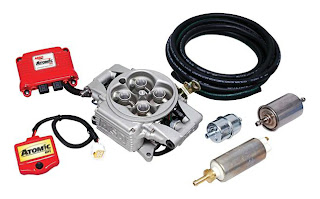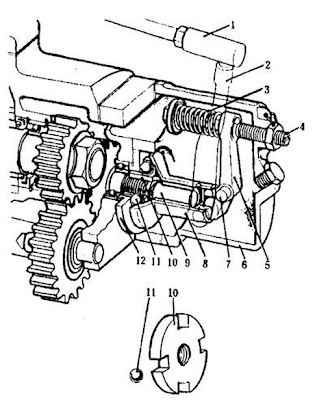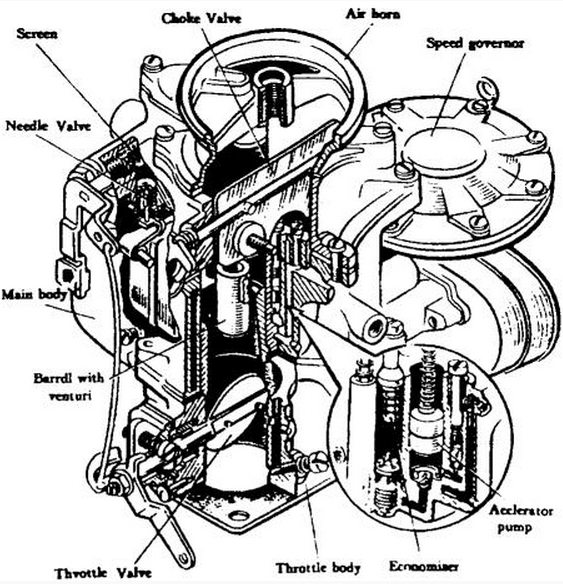If not controlled, the automobile can give off pollutants from four places. Pollutants can come from the fuel tank, the carburetor, the crankcase, and the tail pipe. Pollutants from the fuel tank and carburetor consist of gasoline vapors. Pollutants from the crankcase consist of partly burned air-fuel mixture that has blown by the piston rings. Pollutants from the tail pipe consist of partly burned gasoline (HC), carbon monoxide (CO), nitrogen oxides (NOx), and if there is sulfur in the gasoline, sulfur oxides (SOx).
 |
| Emission Control Systems |
A portion ò the air-fuel mixture remains incompletely burned during the combustion process. This incomplete combustion results in the formation of hydrocarbons (HC), and oxides of nitrogen (NOx). Excessive amounts of these emissions form a major contribution to atmospheric pollution and can constitute a serious health hazard.
Almost two-thirds of the emissions produced in the combustion process are carried away from the engine and expelled into the atmosphere through the automobile exhaust system. It is impossible to seal off the exhaust system because any attempt to stop the flow of exhaust gases would produce a backpressure that would stop the combustion process. Consequently, research has been directed toward reducing the harmful emission contained in the exhaust as to as low a level as possible.
Many common causes of excessive emissions can be attributed to a malfunctioning engine or engine auxiliary system. Some authorities estimate that it is possible to cut emissions by as much as 50 to 60 percent if the vehicle is properly tuned. A further reduction of emissions depends on the use of specially designed emission control systems.
Approximately 15 percent of the vehicle emissions that contribute to atmospheric pollution are in the form of vapors tat escape from the fuel tank and carburetor float bowl. Most evaporative fuel losses occur at the fuel tank and result from the expansion and contraction of air in the tank as the tank heats up or cools. The expanding air escapes through the tank vent tube or vented cap, carrying fuel vapors with it.
Several different evaporative emission control systems have been developed to prevent the loss of fuel vapors to the atmosphere. In general, these are closed systems which provide for the return of fuel vapors from the fuel tank and carburetor to the engine where they are burned. As such, these systems are sometimes called fuel-vapor recovery systems or canister storage systems. Depending on the type of system, the fuel vapors are first collected and stored either in a charcoal canister or in the engine crankcase.
Some evaporative emission –control systems use a charcoal canister as the storage receptacle for the fuel vapors. The General Motors fuel-vapor recovery system is an example of this type. This system consists of a special fuel tank, vacuum/pressure filler cap, vapor/liquid separator standpipe assembly, carbon canister, canister purge hoses, and a modified carburetor. Fuel vapors that would ordinarily escape to the atmosphere are directed into the canister by venting the fuel tank (or, in some applications, by venting the carburetor float bowl as well) where they are absorbed by the charcoal and stored until use. The fuel vapor is removed from the canister by manifold vacuum and burned in the engine.
A carbon (vapor) canister is an integral part of a gasoline engine fuel vapor recovery system. These canisters may be classified as open-bottom or closed-bottom.
A three-tube canister provides for venting both the fuel tank and the carburetor float bowl. Fuel vapors in the float bowl flow through a hose to a third tube and are absorbed by the carbon. The purging method is identical to the one for a two-tube canister
The three-tube canister has been improved to prevent venting of the carburetor float bowl during engine operation. A spring-biased diaphragm valve, which is normally open, controls the flow of fuel vapors from the carburetor to the canister. When the engine is not running, spring tension holds the valve open, allowing normal venting. When the engine is started, manifold vacuum pulls the diaphragm up to close the valve.
In the road-cirafuventilation system, openings at both the front and back of tube crankcase are used to provide a through-pas-sage for ventilation. The front opening con-nects to the oil filter cap and the opening at the back of the crankcase connects to a road-draft tube. Forward movement of the vehicle creates slight vacuum at the road-draft tube opening and a slight pressure of air around the oil filler pipe located under the hood. These pressure differences draw in fresh air to ventilate the crankcase and suck the fule and exhaust fumes into the air cleaner or intake manifold.
Unlike the road-draft system, the positive-crankcase-venti-lation system (PCV) does not rely on vehicle movement for its operation, but instead uses manifold vacuum to maintain a positive movement of air through the crankcase at all engine speeds this greatly reduces the accumulation of harmful deposits when driving in heavy, stop-and –go traffic. The PCV system also results in increased gas mileage because the fuel vapors from the crankcase are drawn into the engine and burned instead of being lost to the atmosphere.
Fresh air enters the system from the clean-air side of the air cleaner or through a separate breather filter. Because intake-manifold vacuum is used to operate the PCV system, the PCV flow into the intake manifold must be regulated so that it varies in proportion to the regular air-ruel ratio being drawn into the intake manifold through the car-buretor. A PCV valve is used to regulate the airflow through the system and into the intake manifold. It is designed to vary the amount of airflow according to the various modes of engine operation
A plunger-type PCV valve consists of a coil spring, plunger, and a valve body. The amount of PCV valve opening or restriction is governed by the amount of vacuum present in the intake manifold. High vacuum overcomes the force of the valve spring and causes the plunger to bottom in the manifold end of the valve housing, thereby restricting the airflow to the intake manifold. At low vacuum, the spring force is stronger than the vttcuum pull, and the valve plunger is forced toward the crankcase end of the valve housing, allowing greater airflow to the intake manifold.















